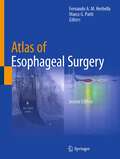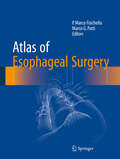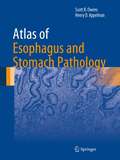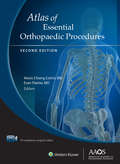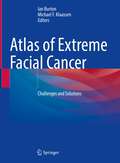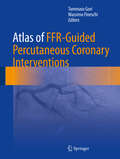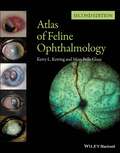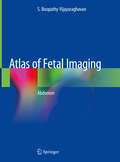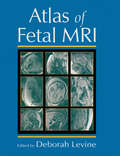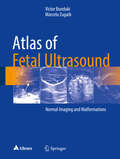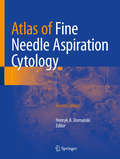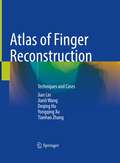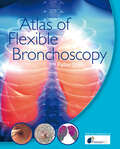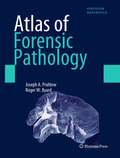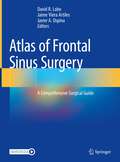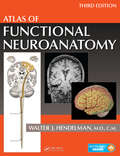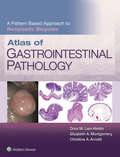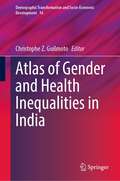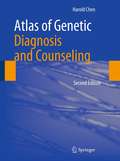- Table View
- List View
Atlas of Esophageal Surgery
by Marco G. Patti Fernando A. M. HerbellaThis Atlas focuses on surgical techniques used to treat the entire spectrum of esophageal diseases. Surgical “pearls” and tips on how to select and perform the correct operation are included and based both on evidence-based data and the experience of the Editors.Step-by-step descriptions of operative and endoscopic procedures in esophageal surgery are provided. Each chapter describes the current indications, perioperative management strategies, and a detailed operative approach with relevant technical considerations.The description of approaches and surgical techniques used in esophageal surgery are outlined in an easily understandable manner for the specific target audience. This book is written by world-class internationally renowned esophageal surgeons and gastroenterologists
Atlas of Esophageal Surgery
by P. Marco Fisichella Marco G. PattiThis Atlas focuses on the description of approaches and surgical techniques used to treat the entire spectrum of esophageal diseases. Surgical "pearls" and tips on how to select and perform the correct operation are included and based both on evidence-based data and the experience of the Editors. Step-by-step descriptions of 14 operative procedures in esophageal surgery are provided. Each chapter describes the current indications, perioperative management strategies, and a detailed operative approach with relevant technical considerations. The description of approaches and surgical techniques used in esophageal surgery are outlined in an easily understandable manner for the specific target audience.
Atlas of Esophagus and Stomach Pathology (Atlas of Anatomic Pathology)
by Henry D. Appelman Scott R. OwensAtlas of Esophagus and Stomach Pathology provides an image-based resource for those studying normal histology of the upper gastrointestinal tract, as well as the microscopic manifestations of developmental abnormalities, toxic insults, infectious diseases, inflammatory and autoimmune conditions, and neoplasia in the esophagus and stomach. Because modern gastrointestinal pathology practice centers on specimens obtained during endoscopic examination, the atlas focuses on biopsy pathology, providing "real-world" microscopic images and ancillary diagnostic studies for most commonly-encountered abnormalities and diseases affecting these two organs. The book is supplemented with endoscopic and special study images. Authored by nationally and internationally recognized pathologists, Atlas of Esophagus and Stomach Pathology is a valuable tool for both pathologists-in-training seeking to make "new acquaintances", and practicing surgical pathologists in need of a quick visual reference in recalling "old friends" in the world of diagnostic gastrointestinal pathology.
Atlas of Essential Dermatopathology
by Andrea Primiani Lyn M. Duncan Kasia S. MasterpolThe book is not intended to be an all-encompassing atlas or textbook but rather a foundation of principles in dermatopathology, highlighting key elements in the field for trainees and will also serve as a basic resource for the pathologist in general practice. In addition to the sketches and minimal text, we envision accompanying high resolution histopathologic micrographs for ultimate correlation as well.
Atlas of Essential Orthopaedic Procedures, Second Edition
by Alexis C. Colvin Evan FlatowCovering more than 100 fundamental orthopaedic techniques, Atlas of Essential Orthopaedic Procedures, 2nd edition offers a highly illustrated, step-by-step guide to the wide variety of conditions you’re most likely to see in practice. The easy-to-follow format begins with patient selection, walks you through a detailed, step-by-step description of the procedure, and concludes with the author’s surgical pearls—all heavily illustrated with radiographs, intraoperative photographs, and line drawings for optimal visualization of the procedure. This technique-focused reference is an essential resource for busy orthopaedic surgeons and a must-have reference for orthopaedic residency.
Atlas of Extreme Facial Cancer: Challenges and Solutions
by Ian Burton Michael F. KlaassenThis book shares an expert experience in managing difficult facial skin cancer and presents rare cases from the authors's own practice. The content follows an anatomical approach based on the complex and often staged reconstruction of extreme facial skin cancer. Written in a clear and logical format, it is intended as a guideline atlas and surgical handbook, defining the principles of CLEAR (Complete Local Excision of the cancer + Aesthetic Reconstruction) and DRAPE (Delayed Reconstruction After Pathological Examination) for reconstructing the face. The book incorporates a wealth of multi-disciplinary knowledge from surgeons, anaesthetists, research scientists, speech / swallowing therapists, pathologists, radiologists and prosthetic rehabilitation specialists. The surgical techniques presented here require a high degree of expertise. Accordingly, the book will be of interest to professionals in the fields of Plastic and Oral and Maxillofacial Surgery, as well as Dermatology.
Atlas of FFR-Guided Percutaneous Coronary Interventions
by Tommaso Gori Massimo FineschiThis book reviews the theory and practice of fractional flow reserve (FFR)-guided coronary intervention, a technique that gives sense and a rationale to daily decisions in the interventional suite. FFR guidance provides detailed information on coronary hemodynamics for the interventional cardiologist. This technique has profound practical implications for therapeutic decisions and for the prognosis of patients. The Atlas of FFR-Guided Percutaneous Coronary Interventions provides practicing physicians clear information to understand both the complexity of the technique and the correct way to apply it. It is designed both to assist younger faculty and those in training, and to act as a clinical resource for more experienced practitioners. Using the clinical cases outlined, the reader can learn to appreciate the pitfalls, tips and tricks that simplify the performance and interpretation of FFR and iFR.
Atlas of Feline Ophthalmology
by Kerry L. Ketring Mary Belle GlazeSuccessful management of eye disease relies on the veterinarian’s ability to identify ocular features and distinguish pathologic changes. Atlas of Feline Ophthalmology, Second Edition is an invaluable diagnostic reference, providing high-quality color photographs for comparison with a presenting complaint. Presenting 394 photographs illustrating both normal and pathologic ocular conditions, this Second Edition offers a current, complete reference on ocular diseases, adding conditions recognized since publication of the first edition, a broader geographic scope, and many new images with improved quality. Carefully designed for easy reference, the contents are divided into sections corresponding to specific anatomical structures of the eye. A useful appendix new to this edition groups figures by etiology, making it easy to find every image associated with a specific agent or disease. Atlas of Feline Ophthalmology, Second Edition is a useful tool aiding general practitioners in diagnosing eye disease in cats.
Atlas of Fetal Imaging: Abdomen
by S. Boopathy VijayaraghavanThis atlas presents the sonographic features of the normal fetal abdomen at different gestational ages, and describes the anomalies of different organ systems in the fetal abdomen. It covers the gastrointestinal tract, genitourinary tract, and abdominal wall defects with the help of numerous ultrasound images, and also addresses differential diagnosis using various sonographic images of the fetal abdomen, as well as effective diagnostic approaches for these conditions.
Atlas of Fetal MRI
by Deborah LevineThe only text to provide in-depth illustrations of the normal and abnormal fetal anatomy on MR imaging, this guide includes chapters highlighting the state-of-the-science in the imaging of the fetal skull, face, neck, nervous system, chest, abdomen, and musculoskeletal system. Discussing applications at the forefront of the discipline, this referen
Atlas of Fetal Ultrasound: Normal Imaging and Malformations
by Victor Bunduki Marcelo ZugaibThe present book is an illustrated guide on fetal medicine, including a wealth of normal and pathological/malformations ultrasound images, throughout the whole pregnancy. Thus, the book intends to fill two gaps in once: The lack of a material discussing the basic principles of fetal ultrasound, which are the basement for a more efficient learning in fetal medicine. . The need for a thorough approach in fetal medicine, presenting both normal and pathological imaging, allowing a detailed evaluation of clinical conditions of importance in prenatal care and follow up. The Atlas of Ultrasound Imaging is an up to date guide to all obstetricians, gynecologists and pediatricians who intend to upgrade their knowledge in fetal medicine, as well as to any other professional, professor, student or research interested in fetal ultrasound.
Atlas of Fine Needle Aspiration Cytology
by Henryk A. DomanskiThis updated and expanded second edition covers all of the diagnostic areas where FNAC is used today. Each chapter follows a similar, practical format: diagnostic criteria with an emphasis of differential diagnoses; diagnostic problems and pitfalls; and relevant findings of ancillary methods. Authoritative discussions will reflect accepted international viewpoints. The interaction of the cytologist or cytopathologist with other specialists (radiologists, oncologists and surgeons) is emphasized and illustrated throughout. With contributions from experts in the field internationally and many new colour images Atlas of Fine Needle Aspiration Cytology, Second Edition provides a comprehensive and up-to-date guide to FNAC for pathologists, cytopathologists, radiologists, oncologists, surgeons and others involved in the diagnosis and treatment of patients with suspicious mass lesions.
Atlas of Finger Reconstruction: Techniques and Cases
by Jian Lin Jianli Wang Deqing Hu Yongqing Xu Tianhao ZhangThis book covers latest advancement of finger reconstruction caused by severe injury leading to finger defects, presenting amount of valuable clinical experience and research achievement. This book provides practical guidance for hand and foot surgeons, micro- and reconstructive surgeons, trauma surgeons, orthopedic surgeons, general practitioners as well as trainees.The book mainly contains two parts: Part 1 focuses on development of the history of finger reconstruction, applied anatomy of the extremities, commonly used equipment and materials, frequently used medicines, preoperative treatment, selection of anesthesia, fundamental skill for finger reconstruction, postoperative treatment and management and methods of functional recovery after finger reconstruction. It is not uncommon in clinical scenarios that severe traumas caused by high energy damage in hands leading to life-long disability. The initial injury management is crucial. Surgeons face the arduous task of attempting to repair and reconstruct the injuries, reduce the patient’s disability and improve their quality of life. Part 2 demonstrates the concepts of different types of finger reconstruction with key points described by case presentations. Depending on the types and the severity of the lesions, accuracy of doctor’s judgment and proficiency of surgery skill have vital significance during the treatment of hand trauma together with patients’ compliance on functional rehabilitation.
Atlas of Flexible Bronchoscopy
by Pallav ShahThis unique and comprehensive atlas by an expert practioner provides an innovative pictorial guide to flexible bronchoscopy, one of the most exciting and challenging procedures in respiratory medicine today.Includes the very latest procedures and techniquesComprehensive coverage, guides you through the range of anatomical and pathological possibili
Atlas of Forensic Histopathology
by Peter M. Cummings Kimberley M. Springer Darin P. TrelkaThis atlas describes the histologic changes relevant to the modern practice of forensic pathology. It guides the reader through the common questions that the forensic pathologist will need to answer in relation to the cause of death, such as: is this feature artifact or is this real? What does this signify? How old is this injury? The book focuses on key issues of forensic importance - e.g. sudden death, environmental deaths, injury timing and suspected child abuse. The book is highly illustrated with color photographs to increase the understanding of changes related to disease, decomposition and artifact. All illustrations are also available on a CD-ROM packaged with the print book. Ideal as a source of quick reference next to the microscope, this is essential reading for forensic pathologists, forensic pathology fellows, pathologists who consult in forensic cases, pathology residents, autopsy pathologists, coroners and forensic investigators.
Atlas of Forensic Pathology: A Pattern Based Approach
by Walter L KempAtlas of Forensic Pathology: A Pattern-Based Approach, by Dr. Walter L. Kemp (Montana State Medical Examiner), Dr. Rhome L. Hughes, and Dr. Jeffrey J. Barnard (Dallas County Chief Medical Examiner) provides a highly illustrated succinct “day-to-day” educational guide to the interpretation of patterns of findings at forensic autopsy to best allow for an accurate determination of cause and manner of death. The format of the book will also guide a pathologist in how to identify pertinent information (i.e., how to search for the patterns) and assemble a thorough and streamlined autopsy report.
Atlas of Forensic Pathology: For Police, Forensic Scientists, Attorneys, and Death Investigators
by Roger W. Byard Joseph A. PrahlowThe Atlas of Forensic Pathology, For Police, Forensic Scientists, Attorneys and Death Investigators is a Major Reference Work that is specifically is designed for non-pathologists who normally interact with forensic pathologists. Chapters 1 through 6 will provide background information regarding medicine, pathology, forensic pathology, death investigation, cause, manner and mechanism of death, death certification, and anatomy and physiology. The next 3 chapters will deal with general topics within forensic pathology, including the forensic autopsy, postmortem changes and time of death, and body identification. Chapters 10 through 20 will detail the major types of deaths encountered by forensic pathologists, including natural deaths, drug/toxin deaths, blunt force injuries, gunshot wounds, sharp force injuries, asphyxia, drowning, electrocution, temperature-related injuries, burns and fires, and infant/childhood deaths. The final chapter includes brief descriptions dealing with various miscellaneous topics, such as in-custody deaths, homicidal deaths related to underlying natural disease, and artifacts in forensic pathology. This atlas differs from competition in that no atlas currently exists that address material for non-pathologists (detectives, forensic entomologists and pathologists), who normally interact with forensic pathologists. The book will present such images that are or interest to not only forensic pathologists but also of interest to odontology, anthropology, crime scene investigators, fingerprints specialists, DNA specialists and entomologists, etc. The competing atlases present images of interest mostly to medical examiners, forensic pathologists and pathologists and consist mostly of wounds, and trauma with some coverage of diseases. The color photographs will come from the collection of over 50,000 slides in the Adelaide Australia collection and some 100,000 slides from the collection compiled by Dr. Prahlow that includes slides from Cook County, Indianapolis, and North Carolina.
Atlas of Forensic and Criminal Psychology
by Bernat-N. TiffonOriginally published in Spanish in 2017 by Libreria Bosch, Barcelona, the Atlas of Forensic and Criminal Psychology is a one-of-kind book made available in English for the first time. This unique work is highly illustrated with full-color images, providing a medico-legal examination of forensic pathology as it relates to cases of forensic psychological interest. The book begins with a historical perspective and includes images of patients to familiarize the reader with symptoms, the hazard-risk criteria, lethality, and suicidal rescue—research that Dr. Tiffon has addressed in his previous publications. Chapters present photographic records of cases to deepen forensic, psychologist, and medico-legal professionals’ insight into thoughts, behaviors, and mechanisms of self- and hetero-aggressiveness. Such cases illustrate the outcomes of various disorders manifested in individuals and victims; as such, they provide an understanding of the psychological-legal conclusions reached in such cases in order to adapt the legal and preventative measures for specific situations. Coverage includes affective, schizophrenic, and personality disorders as contributing elements in diagnostic judgments, noting the great difficulty such examples present to experts performing psychopathological evaluations after criminal, and often violent, events have occurred. Various psychopathological disorders are addressed as well as the technical treatment that should occur in each case from a psychological-forensic perspective. Features: • Presents a provocative look at various syndromes familiar to forensic psychologists, as applied to criminal cases and the pathology of suicide victims and homicide perpetrators • Combines the work of world-renowned expert contributors to examine the criminal, legal, and psychological facets of various diagnoses and case examples • Offers insight into the psychological state of suicide victims, considering their state of mind as a "psychological autopsy" In his previous books published in Spanish, Manual of Consulting in Psychology and Clinical, Legal, Legal, Criminal, and Forensic Psychopathology (2008), Manual of Professional Performance in Clinical, Criminal, and Forensic Psychopathology (2009), and the 4-volume Practical Criminological Atlas of Forensic Psychometry (2019-2020), Tiffon approached forensic psychology and psychopathology from a theoretical perspective. In the Atlas of Forensic and Criminal Psychology, his first book translated into English, Tiffon expands on these prior works, serving to provide a visual reference and guide to medical pathologists and consulting psychologists in cases of disorders in which psychopathological mutilation, injury, and self-injury occur.
Atlas of Frontal Sinus Surgery: A Comprehensive Surgical Guide
by David R. Lobo Jaime Viera Artiles Javier A. OspinaThe atlas offers a comprehensive and up-to-date overview of frontal sinus surgery. In recent years there have been great advances in endoscopic nasosinusal surgery but they have been particularly prominent in frontal sinus surgery. The book provides complete instructions for a gradual learning of the different surgical techniques and includes surgical pearls. It is enriched with videos presenting real-time guidance for frontal sinus endoscopic procedures. The book will meet the needs of both trainees and more experienced practitioners, and will enable them to make steady progress in endoscopic surgery and to adopt a more complete and safe approach to the frontal sinus. It will be of interest also for ophthalmologists, maxillofacial surgeons and neurosurgeons.
Atlas of Full Breast Ultrasonography
by Aristida Colan-GeorgesThis atlas describes andillustrates a novel approach, referred to as full breast ultrasonography (FBU),that represents a challenge to conventional breast imaging diagnosis. Thecoverage encompasses examination technique, diagnostic criteria, the imagingfeatures of a wide variety of lesions, and role in follow-up. FBU involves anatomicultrasound scanning based on the ductal echography technique proposed by MichelTeboul, supplemented by Doppler and real-time sonoelastography. The approach offersa variety of advantages. Compared with MRI it has a lower cost, wider availability,better resolution, and improved correlation with anatomy. Compared withmammography it has the benefits of absence of irradiation and pain, applicabilityin all cases, and better overall accuracy. Furthermore, the standardizedtechnique of acquisition and interpretation means that it is suitable as a screeningtest, unlike classic ultrasonography. FBU is applicable in ultrasound BI-RADSassessment and is of value in depicting both benign and malignant conditions. It can be recommended as a first-line method of diagnosis and for the follow-upof treated breasts, regardless of the patient's age, sex, or physicalcondition.
Atlas of Functional Neuroanatomy
by Walter Hendelman M.D.Understanding how the brain is organized and visualizing its pathways and connections can be conceptually challenging. The Atlas of Functional Neuroanatomy, Third Edition addresses this challenge by presenting a clear visual guide to the human central nervous system (CNS). This edition has been completely reorganized to facilitate learning the stru
Atlas of Gastrointestinal Pathology: A Pattern Based Approach To Neoplastic Biopsies
by Elizabeth A. Montgomery Christina Arnold Dora Lam-HimlinPublisher's Note: Products purchased from 3rd Party sellers are not guaranteed by the Publisher for quality, authenticity, or access to any online entitlements included with the product. Closely mirroring the daily sign-out process, Atlas of Gastrointestinal Pathology: A Pattern Based Approach to Neoplastic Biopsies is a highly illustrated, efficient guide to accurate diagnosis. This practical reference uses a proven, pattern-based approach to clearly explain how to interpret challenging cases by highlighting red flags in the clinical chart and locating hidden clues in the slides. Useful as a daily “scope-side guide,” it features numerous clinical and educational features that help you find pertinent information, reach a correct diagnosis, and assemble a thorough and streamlined pathology report.
Atlas of Gender and Health Inequalities in India (Demographic Transformation and Socio-Economic Development #16)
by Christophe Z. GuilmotoHow will the world's largest population approach its inequality challenges? This volume addresses this question by unraveling different strands of India's emerging health and gender geographies. It is the first book to offer a comparative study of these disparities in India, stressing the deep interaction between health challenges and patriarchal features. Most themes explored in this book illustrate the entangled nature of the social and regional determinants of gender and health imbalances in India. Through its rich cartography of contemporary India, the book represents the first Atlas exploiting district-level figures drawn from the latest sociodemographic survey conducted in 2019-21. After an initial methodological synopsis, the book is built around twenty chapters—illustrated by 75 original maps, figures, and tables prepared by thirty authors—and concludes with a synthesis of India's spatial patterns. Chapters engage with major themes of gender and health inequalities and explore an array of innovative indicators such as access to menstrual hygiene, cesarean deliveries, health insurance, son preference in fertility, female landownership, patrilocal systems, hypertension, anemia, hysterectomy, girl-only or single-child families, or traditional contraception. Together, they provide an often surprising glimpse into the present and future of India's gender and health landscape, highlighting the considerable progress accomplished over the last two decades alongside persistent gaps and emerging issues.
Atlas of Genetic Diagnosis and Counseling
by Harold ChenDr. Chen shares his almost 40 years of clinical genetics practice in a comprehensive pictorial atlas of almost 250 genetic disorders, malformations, and malformation syndromes. The author provides a detailed outline for each disorder, describing its genetics, basic defects, clinical features, diagnostic tests, and counseling issues, including recurrence risk, prenatal diagnosis, and management. Numerous color photographs of prenatal ultrasounds, imagings, cytogenetics, and postmortem findings illustrate the clinical features of patients at different ages, patients with varying degrees of severity, and the optimal diagnostic strategies. The disorders cited are supplemented by case histories and diagnostic confirmation by cytogenetics, biochemical, and molecular techniques, when available. The Atlas of Genetic Diagnosis and Counseling will help all physicians to understand and recognize genetic diseases and malformation syndromes and better evaluate, counsel, and manage affected patients. In this new edition, 47 additional genetic disorders are added, as well as extensive updates made to the previous disorders. New illustrations, as previous edition, will be supplemented by case and family history, clinical features, and laboratory data, especially molecular confirmation.
Atlas of Genetic Diagnosis and Counseling
by Harold ChenThis book, Atlas of Genetic Diagnosis and understanding of these conditions and their care of Counseling, reflects my experience in 38 years of affected individuals and their families. It is also my clinical genetics practice. During this time, I have intention to bring the basic science and clinical m- cared for many patients and their families and taught icine together for the readers. Atlas of Genetic innumerable medical students, residents, and prac- Diagnosis and Counseling is designed for physicians ticing physicians. As an academic physician, I have involved in the evaluation and counseling of patients found that a picture is truly "worth a thousand with genetic diseases, malformations, and malfor- words," especially in the field of dysmorphology. tion syndromes, including medical geneticists, Over the years, I have compiled photographs of my genetic counselors, pediatricians, neonatologists, patients, which are incorporated into this book to developmental pediatricians, perinatologists, obs- illustrate selected genetic disorders, malformations, tricians, neurologists, pathologists, and any phy- and malformation syndromes. A detailed outline of cians and health care professionals caring for each disorder is provided, describing the genetics, handicapped children such as craniofacial surgeons, basic defects, clinical features, diagnostic investiga- plastic surgeons, otolaryngologists, and orthopedics. tions, and genetic counseling, including recurrence I am grateful to many individuals for their risk, prenatal diagnosis, and management. Color invaluable help in reading and providing cases for photographs are used to illustrate the clinical fea- illustration.
